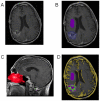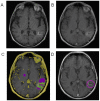A novel method for volumetric MRI response assessment of enhancing brain tumors
- PMID: 21298088
- PMCID: PMC3027624
- DOI: 10.1371/journal.pone.0016031
A novel method for volumetric MRI response assessment of enhancing brain tumors
Abstract
Current radiographic response criteria for brain tumors have difficulty describing changes surrounding postoperative resection cavities. Volumetric techniques may offer improved assessment, however usually are time-consuming, subjective and require expert opinion and specialized magnetic resonance imaging (MRI) sequences. We describe the application of a novel volumetric software algorithm that is nearly fully automated and uses standard T1 pre- and post-contrast MRI sequences. T1-weighted pre- and post-contrast images are automatically fused and normalized. The tumor region of interest is grossly outlined by the user. An atlas of the nasal mucosa is automatically detected and used to normalize levels of enhancement. The volume of enhancing tumor is then automatically calculated. We tested the ability of our method to calculate enhancing tumor volume with resection cavity collapse and when the enhancing tumor is obscured by subacute blood in a resection cavity. To determine variability in results, we compared narrowly-defined tumor regions with tumor regions that include adjacent meningeal enhancement and also compared different contrast enhancement threshold levels used for the automatic calculation of enhancing tumor volume. Our method quantified enhancing tumor volume despite resection cavity collapse. It detected tumor volume increase in the midst of blood products that incorrectly caused decreased measurements by other techniques. Similar trends in volume changes across scans were seen with inclusion or exclusion of meningeal enhancement and despite different automated thresholds for tissue enhancement. Our approach appears to overcome many of the challenges with response assessment of enhancing brain tumors and warrants further examination and validation.
Conflict of interest statement
Figures






Similar articles
-
Magnetic resonance imaging volumetric assessment of the extent of contrast enhancement and resection in oligodendroglial tumors.J Neurosurg. 2012 Jun;116(6):1172-81. doi: 10.3171/2012.2.JNS102032. Epub 2012 Mar 16. J Neurosurg. 2012. PMID: 22424566
-
A novel, reproducible, and objective method for volumetric magnetic resonance imaging assessment of enhancing glioblastoma.J Neurosurg. 2014 Sep;121(3):536-42. doi: 10.3171/2014.4.JNS121952. Epub 2014 Jul 18. J Neurosurg. 2014. PMID: 25036205 Free PMC article.
-
5-ALA complete resections go beyond MR contrast enhancement: shift corrected volumetric analysis of the extent of resection in surgery for glioblastoma.Acta Neurochir (Wien). 2014 Feb;156(2):305-12; discussion 312. doi: 10.1007/s00701-013-1906-7. Epub 2013 Oct 25. Acta Neurochir (Wien). 2014. PMID: 24449075
-
Automated quantitative tumour response assessment of MRI in neuro-oncology with artificial neural networks: a multicentre, retrospective study.Lancet Oncol. 2019 May;20(5):728-740. doi: 10.1016/S1470-2045(19)30098-1. Epub 2019 Apr 2. Lancet Oncol. 2019. PMID: 30952559
-
Alpha shape theory for 3D visualization and volumetric measurement of brain tumor progression using magnetic resonance images.Magn Reson Imaging. 2015 Jul;33(6):787-803. doi: 10.1016/j.mri.2015.03.008. Epub 2015 Apr 9. Magn Reson Imaging. 2015. PMID: 25865822 Review.
Cited by
-
How treatment monitoring is influencing treatment decisions in glioblastomas.Curr Treat Options Neurol. 2015 Apr;17(4):343. doi: 10.1007/s11940-015-0343-8. Curr Treat Options Neurol. 2015. PMID: 25749847
-
Editorial on "heat shock protein peptide complex-96 (HSPPC-96) vaccination for recurrent glioblastoma: a phase II, single arm trial".Neuro Oncol. 2014 Jan;16(2):169-70. doi: 10.1093/neuonc/not311. Neuro Oncol. 2014. PMID: 24443362 Free PMC article. No abstract available.
-
Ellipsoid calculations versus manual tumor delineations for glioblastoma tumor volume evaluation.Sci Rep. 2022 Jun 22;12(1):10502. doi: 10.1038/s41598-022-13739-4. Sci Rep. 2022. PMID: 35732848 Free PMC article.
-
Real-time multi-modality imaging of glioblastoma tumor resection and recurrence.J Neurooncol. 2013 Jan;111(2):153-61. doi: 10.1007/s11060-012-1008-z. Epub 2012 Dec 16. J Neurooncol. 2013. PMID: 23242736 Free PMC article.
-
Quality measures for fully automatic CT histogram-based fat estimation on a corpse sample.Sci Rep. 2022 Nov 23;12(1):20147. doi: 10.1038/s41598-022-24358-4. Sci Rep. 2022. PMID: 36418341 Free PMC article.
References
-
- Jaffe CC. Measures of response: RECIST, WHO, and new alternatives. J Clin Oncol. 2006;24:3245–3251. - PubMed
-
- Suzuki C, Jacobsson H, Hatschek T, Torkzad MR, Boden K, et al. Radiologic measurements of tumor response to treatment: practical approaches and limitations. Radiographics. 2008;28:329–344. - PubMed
-
- Macdonald DR, Cascino TL, Schold SC, Jr, Cairncross JG. Response criteria for phase II studies of supratentorial malignant glioma. J Clin Oncol. 1990;8:1277–1280. - PubMed
-
- Therasse P, Arbuck SG, Eisenhauer EA, Wanders J, Kaplan RS, et al. New guidelines to evaluate the response to treatment in solid tumors. European Organization for Research and Treatment of Cancer, National Cancer Institute of the United States, National Cancer Institute of Canada. J Natl Cancer Inst. 2000;92:205–216. - PubMed
Publication types
MeSH terms
Grants and funding
LinkOut - more resources
Full Text Sources
Other Literature Sources
Medical

